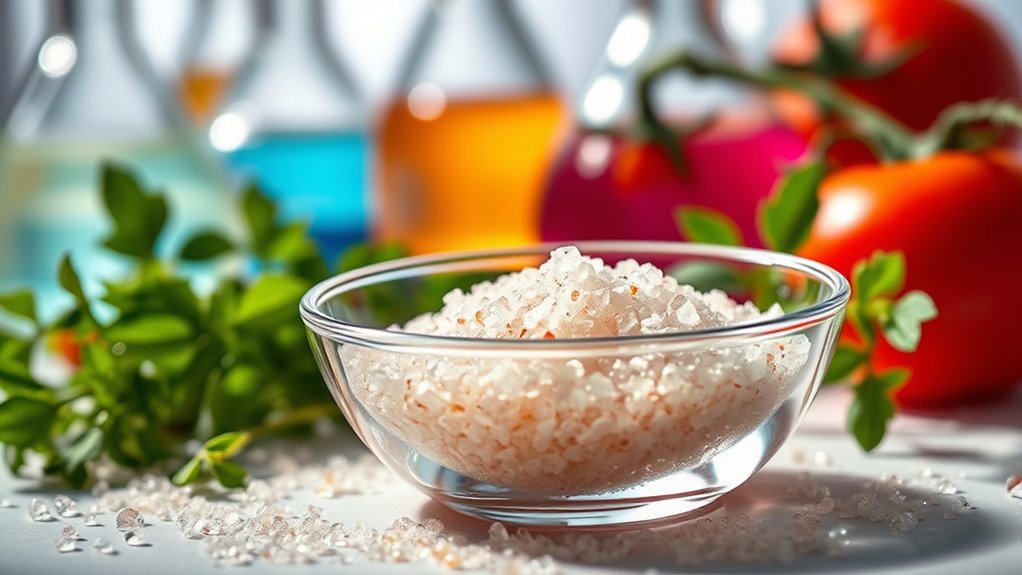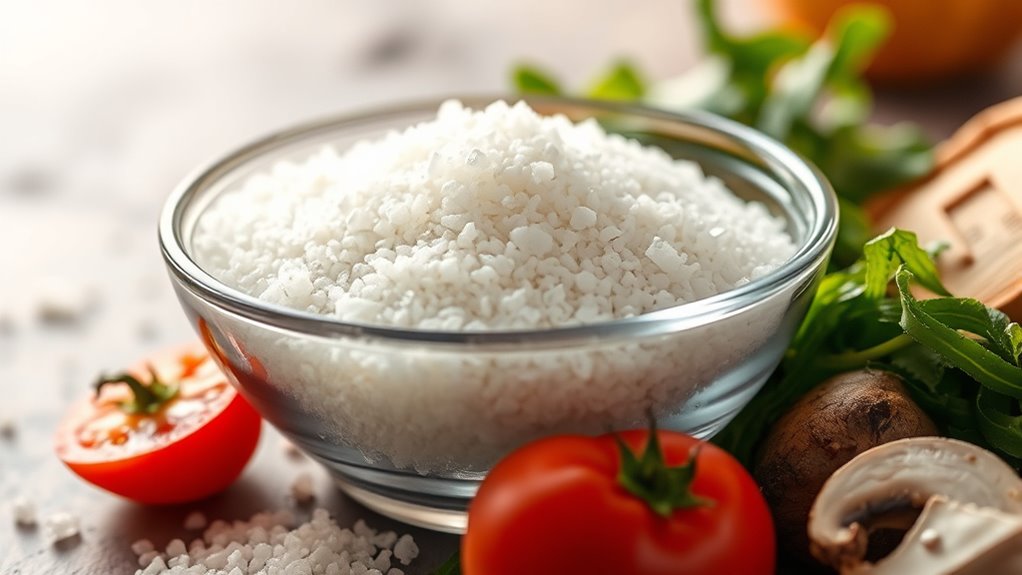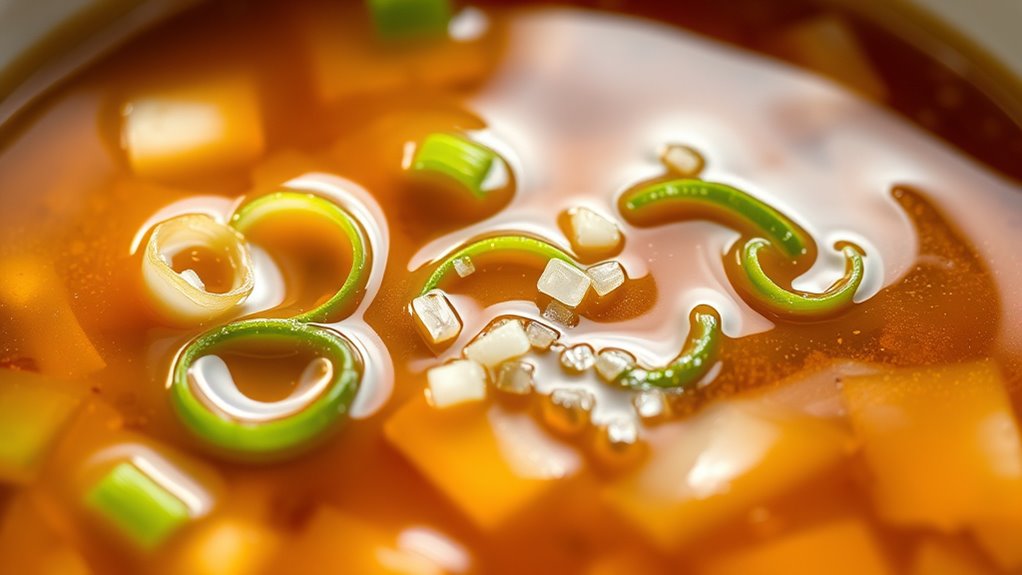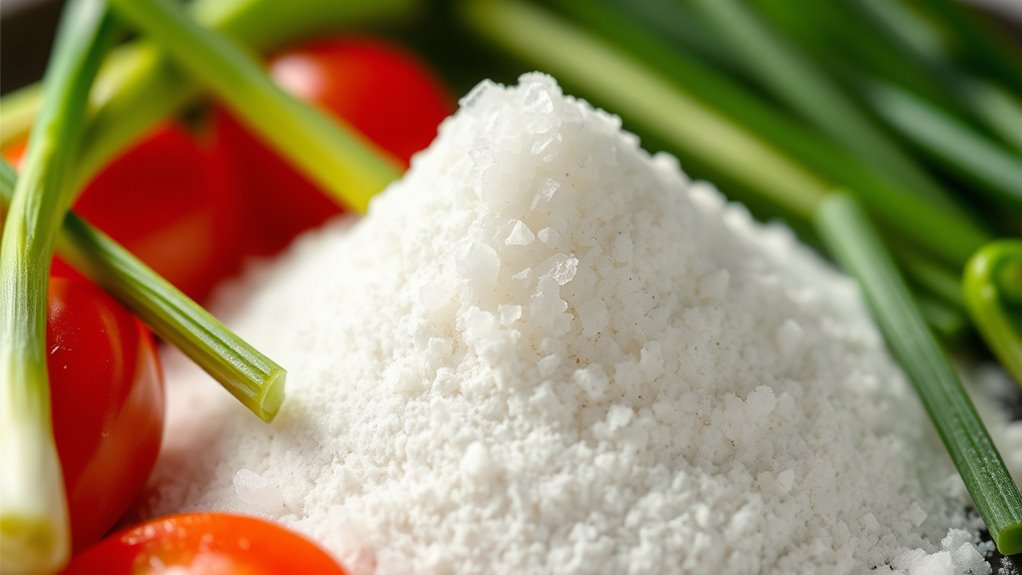MSG is a safe, naturally occurring compound, the sodium salt of glutamic acid, that enhances umami flavor by binding to taste receptors. It dissociates into glutamate and sodium in water, triggering savory signals, especially when combined with other compounds like IMP. Its stability during cooking and presence in natural foods like tomatoes and mushrooms make it an effective flavor booster. If you want to uncover the science behind its safety and how it naturally enhances flavor, keep exploring.
Key Takeaways
- MSG is a safe, naturally derived flavor enhancer that boosts umami by activating specific taste receptors on the tongue.
- It dissociates into glutamate and sodium in water, mimicking natural umami compounds found in many foods.
- The umami taste results from glutamate binding to G-protein coupled receptors, enhanced by synergistic compounds like IMP and GMP.
- Concerns about MSG’s health effects are largely based on animal studies; human data shows it is safe at typical consumption levels.
- Natural sources like tomatoes, seaweed, mushrooms, and fermented products can enhance umami without synthetic additives.
Understanding the Chemical Identity of MSG and Umami

To understand the chemical identity of MSG and its role in umami, it’s important to recognize that MSG is the sodium salt of glutamic acid, a naturally occurring amino acid. Its chemical formula is C5H8NO4Na, and the IUPAC name is sodium 2-aminopentanedioate. You can find glutamic acid naturally in foods like tomatoes and seaweed, which contribute to their savory flavors. MSG is widely used as a flavor enhancer because it boosts the umami taste, one of the five basic flavors that describes a savory or meaty sensation. When added to food, MSG interacts with taste receptors on your tongue, intensifying the overall flavor profile. Its stability and water solubility make it a versatile ingredient in cooking and food processing worldwide. Additionally, market growth in AI technology is projected at over 40% CAGR by 2025, highlighting the rapid advancements and increasing integration of technology in various fields. Understanding the chemical properties of MSG helps to clarify its effectiveness and safety as a flavor enhancer. Recognizing its subconscious influence in food perception can also enhance our understanding of flavor enhancement techniques.
The Molecular Structure and Dissociation of MSG

The molecular structure of MSG reveals how its chemical composition enables it to enhance flavor. Its formula, C5H8NO4Na, results from replacing a hydrogen atom in glutamic acid with a sodium ion.
The molecule contains a glutamate ion in zwitterionic form, with both positive (ammonium) and negative (carboxylate) charges, bonded ionically to sodium.
In water, MSG dissolves easily, dissociating into sodium cations and glutamate anions, thanks to the ionic bonds that break upon hydration. The glutamate remains in zwitterionic form, maintaining charge balance.
Its high solubility and ionic nature allow free glutamate ions to be released, which then interact with taste receptors. This dissociation process underpins MSG’s ability to boost umami flavor in foods. Understanding ion dissociation is fundamental to appreciating how MSG functions at the molecular level. Additionally, the ionic bonds that hold the molecule together are crucial for its solubility and flavor-enhancing properties.
How Glutamate Creates the Umami Taste

Glutamate creates the umami taste by binding to specific receptors on your taste buds, triggering a cascade of signals that your brain interprets as savory flavor. These receptors, mainly the T1R1/T1R3 heteromeric complex, are activated when glutamate binds to them. The binding initiates G-protein coupling, which sets off intracellular signaling pathways. This process involves changes in ion channels and neurotransmitter release, sending signals to your brain’s taste centers. The presence of other compounds, like IMP and GMP, enhances this signal through synergy, making the umami sensation more intense. It’s not just about the chemical binding; your nervous system processes these signals, providing the rich, savory experience we associate with umami. Interestingly, research into anime movies has shown that complex signaling pathways can produce rich, layered sensory experiences, much like the umami flavor. This mechanism highlights how glutamate’s interaction with taste receptors produces the distinctive umami flavor, and ongoing studies suggest that receptor sensitivity can influence the strength of the umami perception.
Comparing Protein-Bound and Free Glutamate in Foods

Protein-bound glutamate, found mainly in animal-based foods like meat, fish, eggs, and dairy, is stored within peptides and proteins, which means it must be broken down during digestion before your body can absorb it. This form of glutamate is released gradually as proteins are degraded, influencing how your body processes it over time. Additionally, understanding the visualization techniques used in personal development can help improve how you perceive and achieve your goals. Recognizing the gelato flavors and textures in foods can also enhance your sensory experience and appreciation for umami-rich ingredients.
In contrast, free glutamate exists as individual amino acids or salts, making it immediately available for taste perception and absorption. Foods like ripened cheese, cured meats, potatoes, and tomatoes naturally contain high levels of free glutamate, which can enhance flavor instantly.
Processing methods such as curing or fermentation increase free glutamate by breaking down proteins. Understanding the differences helps clarify how your body responds to these two forms of glutamate during digestion and tasting.
The Role of Sodium in MSG and Its Impact on Flavor

Sodium plays a crucial role in MSG’s ability to enhance flavor, particularly its umami and savory qualities. While MSG contains about 12.28% sodium—less than sodium chloride—it still considerably contributes to both salty and savory tastes. The sodium in MSG boosts flavor when combined with other taste compounds, helping to reduce overall salt usage by up to 40% while maintaining flavor integrity. It works synergistically with glutamate and other flavor enhancers, amplifying umami and increasing the palatability of foods like soups. The sodium component interacts with taste receptors, intensifying savory sensations. This balance allows you to enjoy rich, savory dishes with less salt, supporting healthier eating habits without sacrificing flavor. Sodium’s role is essential in creating the satisfying umami experience MSG provides. Understanding the chemistry of flavor can deepen appreciation for how sodium enhances culinary experiences.
The Stability of MSG During Cooking and Food Processing

MSG is notably stable during most cooking and food processing methods, ensuring it continues to enhance umami flavor without breaking down. It withstands typical temperatures used in boiling, simmering, and baking without decomposition. Only at very high temperatures above 350°C would MSG begin to break down, which is beyond normal cooking conditions.
Its molecular structure, a sodium salt of glutamic acid, remains intact under neutral or mildly alkaline pH, common in foods. Even during storage, exposure to oxygen doesn’t markedly affect its stability.
Unlike some ingredients, MSG doesn’t alter food’s color or texture. Its robustness allows it to be incorporated into a wide range of processed foods, such as soups, snacks, and sauces, consistently delivering its savory umami boost without losing potency.
The Production Process of MSG and Its Industrial Uses

The production of MSG has evolved considerably since its early days, shifting from chemical hydrolysis to more efficient fermentation methods. Initially, MSG was made by hydrolyzing vegetable proteins like wheat gluten and soybeans with hydrochloric acid to extract glutamic acid.
Between 1962 and 1973, chemical synthesis using acrylonitrile allowed direct glutamic acid production.
Since the mid-1950s, fermentation has become the dominant method due to its higher efficiency, environmental benefits, and lower costs. In industrial fermentation, bacteria such as Corynebacterium consume sugars from raw materials like sugarcane, sugar beets, tapioca, or molasses, producing glutamic acid.
After fermentation, glutamate is neutralized with sodium, filtered, concentrated, and crystallized into pure MSG. This process supports large-scale production, enabling use in a wide range of processed foods worldwide.
Health Considerations and Scientific Safety of MSG

As MSG becomes more widespread in processed foods, understanding its health implications and safety profile is increasingly important. Animal studies suggest high MSG intake might lead to insulin resistance, obesity, and liver or heart changes, but these doses often exceed typical human consumption.
Human research shows mixed results; some link MSG to modest weight gain, while others find no effect on metabolism or body weight. Regulatory bodies like EFSA consider MSG safe at normal levels.
Concerns about neurotoxicity and reproductive effects mainly stem from animal studies with unrealistically high doses, with limited evidence in humans. Overall, when consumed within standard dietary amounts, MSG is generally regarded as safe, with adverse effects being mild, transient, and rare.
Natural Sources of Umami and Enhancing Flavor in Cooking

Many natural ingredients offer rich umami flavors that can enhance your cooking without relying on additives. Ripe, roasted, or sun-dried tomatoes bring concentrated umami, while seaweeds and sea vegetables add a savory depth. Mushrooms, especially dried shiitake, contain guanylate, a key umami compound, and legumes and grains can also provide subtle umami notes.
Incorporate miso paste, soy sauce, or tamari to amplify flavor, or sprinkle nutritional yeast for a cheesy, nutty taste. Techniques like roasting, drying, fermenting, curing, and aging naturally boost umami by breaking down or concentrating compounds.
Combining ingredients—like shiitake mushrooms with soy sauce or roasted tomatoes with miso—further intensifies savory flavors. These methods and ingredients allow you to enhance dishes naturally, enriching taste without synthetic additives.
Frequently Asked Questions
Does MSG Cause Allergic Reactions or Food Sensitivities?
You might wonder if MSG causes allergic reactions or sensitivities. Scientific evidence shows true MSG allergies are extremely rare, with only a few confirmed cases. Most reactions, like headaches or flushing, aren’t allergic but sensitivities or responses to other food components.
For most people, MSG is safe at typical dietary levels. If you suspect a reaction, consult a healthcare professional to determine if it’s an allergy or sensitivity rather than MSG itself.
Can MSG Intake Affect Blood Pressure or Sodium Levels?
You might think MSG is harmless, but it can actually have a huge impact on your blood pressure and sodium levels. Studies show that consuming MSG over time can raise your systolic and diastolic pressure, especially if you’re sensitive or already hypertensive.
Though MSG contains less sodium than salt, its effects on your kidneys and blood vessels could be significant, so moderation is definitely key to keeping your blood pressure in check.
Are There Differences Between Natural Umami and MSG in Flavor Quality?
You wonder if natural umami and MSG taste different. Natural umami, found in foods like mushrooms and cheese, offers a deeper, more complex flavor because it’s bound to other compounds, developing slowly during cooking.
MSG, on the other hand, provides a concentrated, pure glutamate that quickly boosts flavor. While both enhance umami, natural sources tend to deliver richer, more nuanced tastes, whereas MSG offers immediate, intense flavor enhancement.
How Does FDA Regulation Ensure MSG Safety in Foods?
The FDA guarantees MSG safety by recognizing it as “Generally Recognized as Safe” (GRAS), meaning it’s considered safe based on scientific evidence. They require manufacturers to list MSG on labels, so you can see when it’s used.
The FDA reviews research and monitors new data regularly, confirming that MSG is safe for most people when consumed within recommended amounts, helping you make informed food choices.
Can MSG Be Used to Reduce Overall Sodium in Recipes?
Did you know adding MSG can cut sodium by over 30% in recipes while keeping flavors rich?
You can easily replace half the salt with MSG, which contains about a third less sodium, to lower overall sodium intake.
Use it during cooking to enhance umami and maintain taste.
This approach works well in soups, meats, and vegetables, helping you create healthier, flavorful dishes without sacrificing flavor.
Conclusion
So, next time you sprinkle MSG or savor that savory umami flavor, remember it’s all about chemistry working behind the scenes. It’s a coincidence that this simple molecule enhances taste so profoundly, yet its safety and natural presence in foods are well-supported by science. Embrace the flavor boost without hesitation—sometimes, science and flavor come together in the most unexpected ways to elevate your culinary experience.









